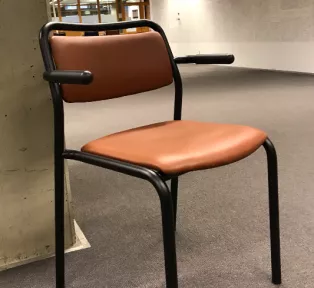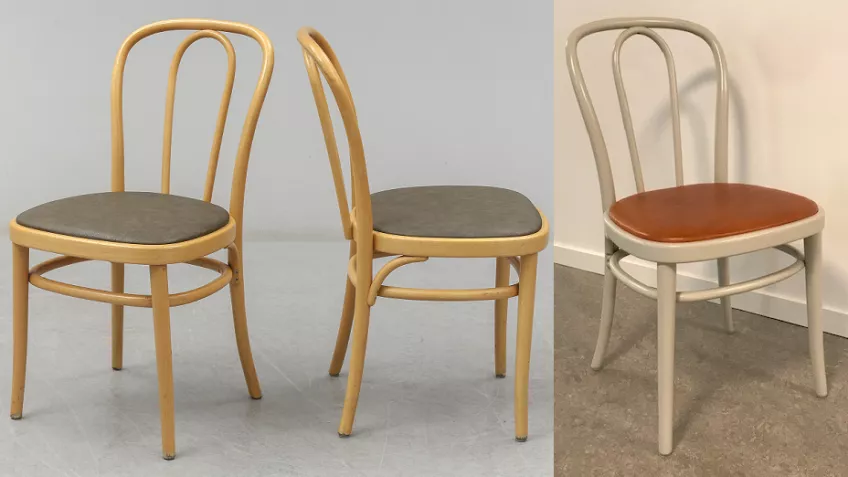Re-use instead of single use
Desks, office chairs, chairs and tables in lecture rooms and study spaces – a large amount of furniture is managed at Lund University every year. The climate impact from this equipment accounts for a large part of the University’s total climate footprint. LU Estates is working to promote re-use and recycling of more furniture.
‟It is important to make the right choice when purchasing new furniture; it should withstand physical wear and tear as well as have a timeless style”, says Carolina Rijpma, project manager for interior design at LU Estates.
She works to support the University’s organisational units in purchasing the right furniture and determining what can be repaired or reused. As an example, she mentions an interior design project at Campus Helsingborg, where the unit chose to purchase design classics made of wood rather than cheaper plastic chairs. With over 10 years’ guarantee from the supplier and the possibility of renovating the chairs in the future, it is still a better alternative from both a financial and environmental perspective. It can also be a matter of purchasing table bases that are adjustable to different widths. This means you only have to change the tabletop to adapt to changing circumstances in the office.
The University has many older pieces of good quality furniture that are worth restoring. Recently, 1300 chairs of the 91 model were re-varnished and re-upholstered in Dalby. The chairs were originally designed by Lindau & Lindecrantz for Lammhults furniture store in 1979 and were created for the Arvidsjaur regiment as a durable and sturdy chair, named after the cartoon character, the 91. The University’s chairs are over 20 years old and can now live for many more years. Carolina finds this model to be suitable for study environments, with an aesthetic that holds up over time and quality able to withstand many students cramming for exams. The newly renovated chairs are located at Campus Helsingborg and the Study Centre at LTH, and will be in the M Building as well, once its renovation is complete. There are also many bentwood chairs that are over 40 years old and still fit for use. In 2019, the Vienna chairs originally delivered by Gemla in 1980, according to their date stamp, were also renovated. New leather on the seats and new varnish made them as good as new. Will they last another 40 years?
One of the challenges of more resource-efficient furniture use, according to Carolina Rijpma, is that the University is decentralised and keeps no common inventory. This makes it difficult to move furniture around between different organisational units and many good opportunities for re-use of existing furniture are missed. Knowledge about how to re-use and renovate furniture must also be prioritised. New guidelines for the organisational units will be produced by Carolina and her colleagues in future. Via the Legal, Financial and Administrative Services Agency, there are new framework agreements for circular flows of furniture to facilitate opportunities to renovate, sell and buy used furniture for the University.
Tips for sustainable furniture use
Stick to uniform furniture design! It is visually more pleasing and makes it easier to renovate.
Start by reviewing your own stock. Check what used furniture is available before purchasing new items. It is not a question of collecting miscellaneous pieces from a flea market; there are agreements in place with companies that sell good quality used office furniture.
Don’t discard furniture that could be renovated!
If you must purchase new furniture, choose items that will last a long time and can be renovated in future.
Buy flexible furniture that can be adapted to changing circumstances, such as table bases that are adjustable to various tabletop sizes.
Sell furniture that you no longer need rather than throwing it away.
Get expert help! Contact LU Estates if you need support.
More about office furniture
Office furniture production in Sweden emits the equivalent of 150 000 tonnes of carbon dioxide per year.
Office furniture lasts for an average of 30 years, but is only used for a few years according to the sector. Read more at the webpage for The National Agency for Public Procurement (in Swedish)
Goods and equipment account for one third of the University’s total climate footprint (in a normal pre-pandemic year).
Read more on the climate footprint pageAbout the new agreement for circular flow of furniture at the University (in Swedish)



